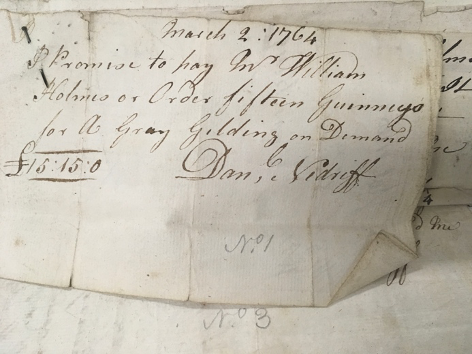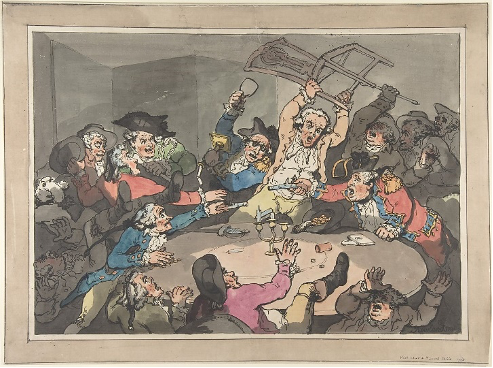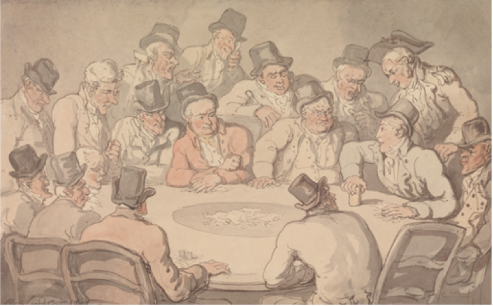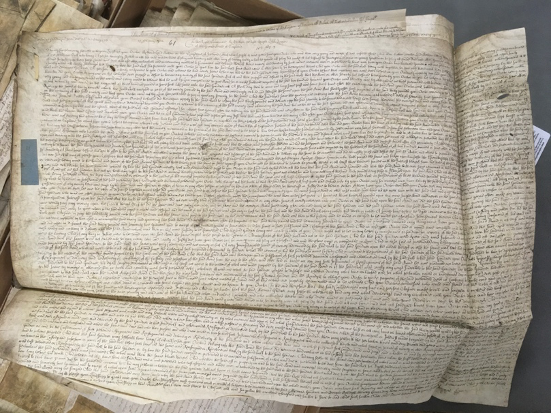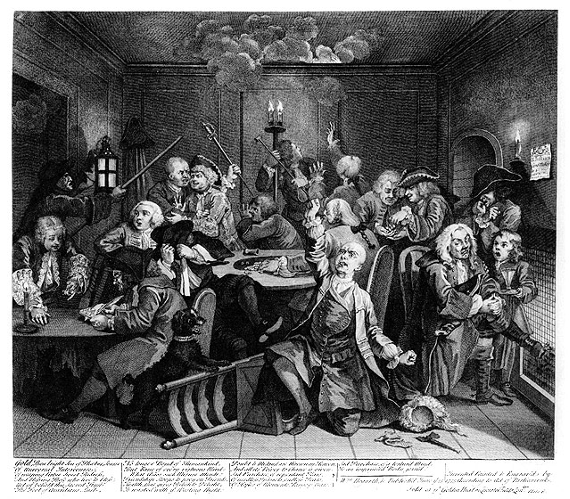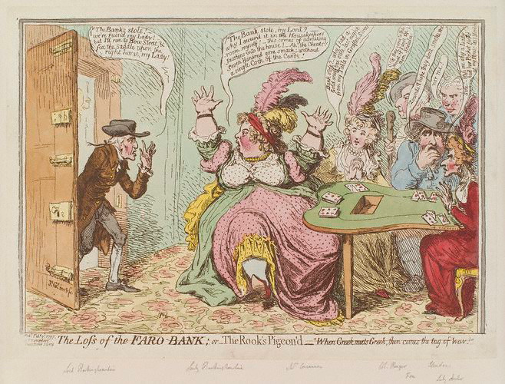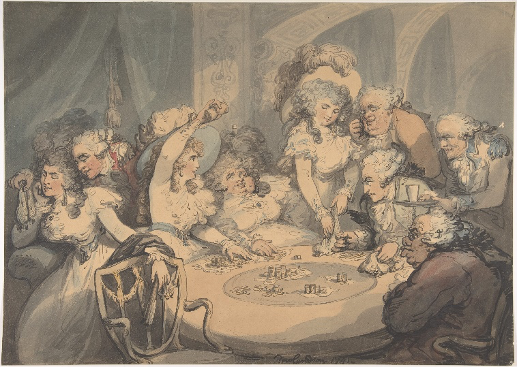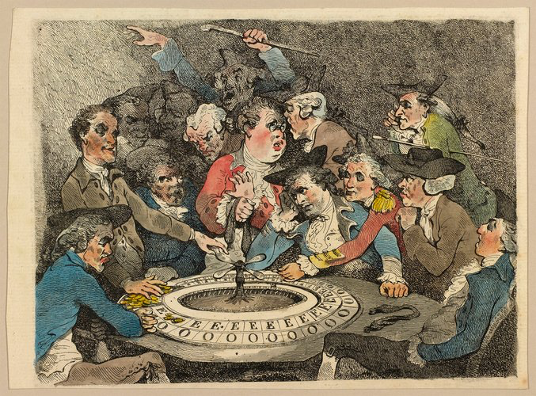Résumé
From the Restoration to the first decade of the Victorian era, gaming and gambling spread through all ranks of society and became favourite pastimes for men and women alike. Gaming usually applies to games of chance, while gambling is found in games involving skills such as card games, tennis or wagers on sports. Throughout the period, various gambling practices were associated with sociable behaviours and values, especially those of the gentleman. Pamphlets increasingly denounced gambling as a vice. The paradox of gambling lies in the fact that it defined a form of sociability but was denounced as anti-social.
From the Restoration to the first decade of the Victorian era, gaming and gambling spread through all ranks of society and became favourite pastimes for men and women alike. Gaming usually applies to games of chance, while gambling is found in games involving skills such as card games, tennis or wagers on sports. Like other writers, we consider in this entry gambling only when it applies to games such as card games, dice, etc.1
Throughout the period, various games or gambling practices went in and out of fashion in England and were associated with sociable behaviours and values, especially those of the gentleman. Different private or public venues welcomed parties of gamesters, from exclusive gambling clubs or elite assemblies at private residences to popular city taverns or coffeehouses where various social classes mingled and indulged in fashionable games, thus fostering new forms of sociable interactions.
Treatises and pamphlets increasingly questioned such activities and denounced gambling as a curse or a vice, which contributed to fuelling the debate about the social benefits or evils of gaming and gambling. This evolution was framed by legislative attempts at curbing their progression and their damaging effects on the social fabric. The Caroline gaming act of 1664 was the first such legislation to address games of chance specifically and elite gaming particularly, while the Victorian gaming act of 1845 recognised games of skill as legal and outlawed games of chance when played either in public or private for money. The 1664 Act formed a model for subsequent gambling legislation throughout the eighteenth century, and acts from 1710, 1739 and 1745 repeated and expanded its prohibitions.
- 1. Samuel Johnson’s Dictionary defines gaming as “to play wantonly and extravagantly for money.”
Other laws aimed, with little success, at suppressing the games of faro, basset or hazard (1739) or at preventing taverns and coffeehouses from serving as gambling dens (acts of 1750).2 The Gaming Acts of 1739 and 1745, designed to curb the gambling craze of the 1720s, had little effect on those who indulged in gambling behind closed doors. In 1782, a bill was aimed more directly at the game of EO (but never became law). The paradox of gambling lies in the fact that it defined a form of sociability but was denounced as anti-social.
- 2. 12 Geo IIc28 et 18 Geo IIc34.
Gambling and the Social worlds of Eighteenth-Century Britain
In his Early History of Charles James Fox, the historian George Trevelyan explained: 'Society was a vast casino. On whatever pretext and under whatever circumstances half a dozen people of fashion found themselves together, [. . .] the box was sure to be rattling, and the cards were being cut and shuffled.'3 From the very beginning of the eighteenth century, England was invaded by a passion for gambling, a cultural and social phenomenon which progressively became an ordinary pastime. It could be encountered in all parts of society, and involved women as well as men.
- 3. G. O. Trevelyan, The Early History of Charles James Fox (London: Longmans, Green & co, 1881), p. 88-89.
Popular classes spent their meagre savings in the numerous gambling houses, taverns or coffee-houses of the capital, even after they were officially forbidden in 1750. The example was set by the upper ranks of society. Gaming was more than an occasional practice, it could define a way of life.4 The Connoisseur confirmed that 'Gaming is now become rather the business than the amusement of our persons of quality.'5
Gambling was also popular with women who, long excluded from independent economic and political activity, found in such rituals a sphere of influence in their role as the arbiters of taste and leaders of fashion. Early satirical plays pointed at the potential danger for the reputation and honour of female players. In the epilogue of James Shirley's The Gamester (1637), women’s virtue is at risk:
This Itch for play has likewise fatal been,
And more the Cupid draws the Ladies in,
A Thousand Guineas for Basset prevails,
A Bait when Cash runs low, that seldom fails;
And when the Fair One can’t the Debt defray
In Sterling Coin, does Sterling Beauty pay.6
- 6. James Shirley, The Gamester (London: John Norton, 1637).
In Susanna Centlivre’s The Basset Table (1705), the main gambling character is a woman who ends up giving up the life-style associated with games in order to marry. In 1705, in his comedy The Tender Husband, Steele exclaimed: 'Oh, the damned Vice! That Women can imagine all Household Care, regard to Posterity, and fear of Poverty, must be sacrificed to a game at Cards.'7 In fact, when she gambles, a lady seems to be at higher risk than a gentleman, since her lost honour cannot be restored. Richard Steele in the Guardian (29 July 1713) deplored: 'Hollow eyes, haggard looks, and pale complexions, are the natural indications of a female gamester. Her morning sleeps are not able to repair her midnight watchings.' However, these considerations did not prevent the gambling fever from spreading among women, while providing material for comedies.8 The most illustrious of them all was Lady Georgiana Spencer, Duchess of Devonshire, seen below casting the dice at hazard. Unhappily married, she also indulged in faro, which became her favourite pastime and a real addiction. She turned Devonshire House into a very reputed and select gaming circle, where professional gamesters were illegally hired and paid 50 guineas a night, as a pretext for laying gambling tables in her home.
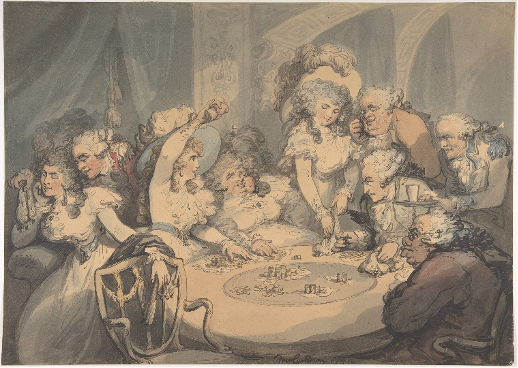
At the beginning of the eighteenth century, games like Ombre, Basset, Piquet, imported from European courts—respectively Spain, France and Italy—were well established in England. Quadrille, a variant of the three-player Spanish card game Ombre, originally played by the French nobility, rapidly spread throughout Europe. In England, it was soon rivalled by Whist.
Whist or Whisk was born in England in 1687. Gentlemen from the West End only appropriated it at the beginning of the eighteenthcentury, thus creating a fashion among worldly circles. In 1742, Edmond Hoyle’s Short Treatise on Whist, in which the rules of the game are defined, became a best-seller. Faro (derived from the word Pharaoh) was one of the oldest games of chance. Players used a deck of fifty-two cards and bet against the bank, held by the one who dealt the cards. Bets were placed on the order in which two cards, drawn from the top of the deck by the banker, appeared. If the fashion for whist dominated the first half of the century, the craze for faro reached enormous proportions between 1750 and 1780.
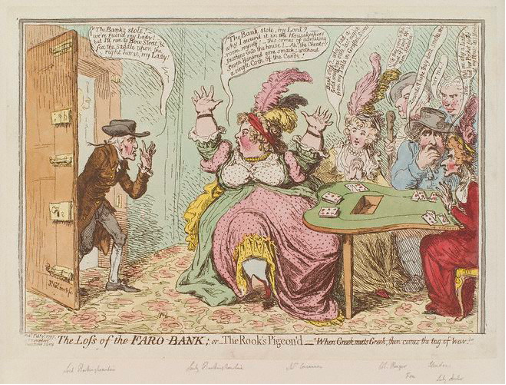
Hazard was very fashionable among the Beau monde. It was played against the bank on a special table, with two dice and with rolls of coins as the stakes could be very high. Because players betted against each other, it could generate a certain amount of passion. While Rowlandson’s The Gaming Table (1801) captures the expressions of the (all male) players who are about to bet on the roll of the dice, his Kick Up at a Hazard Table (1787) satirically depicts the unruliness of the game.
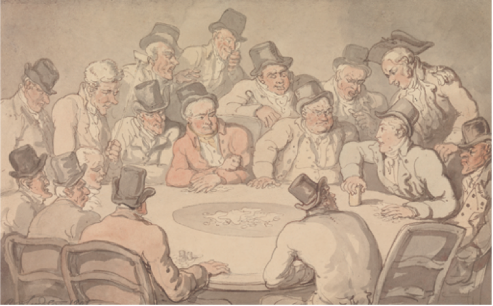
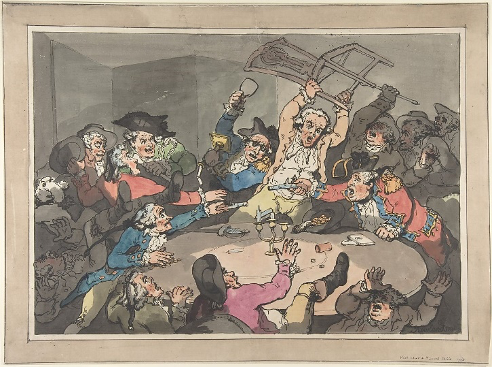
E.O., the ancestor of the French Roulette, also close to Roly Poly, became very popular in the 1770s. It was played with a wheel and a ball just like roulette but, instead of numbers, there were just 20 sections marked E for Even and 20 marked O for Odd. Players would place their bets on where the ball would land.
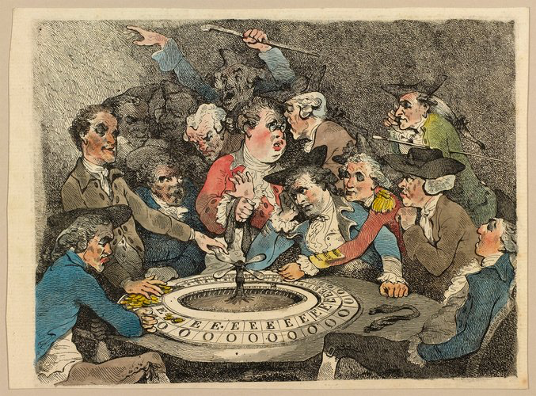
- 7. Richard Steele, The Tender Husband, or the Accomplish’d Fools. A Comedy (London, 1705), The Plays of Richard Steele, ed. Shirley Strumkenny (Oxford: Clarendon Press, 1971).
- 8. In 1754, the Connoisseur regretted: "They [the ladies] are at present very deep in cards and dice." The Connoisseur, n° 15.
Gaming and gambling spread far beyond the confines of specialist gambling clubs like White’s or Brooks's or the more common card clubs. Virtually no type of society was exempt, whether they were social clubs, neighbourhood societies, florists' feasts, medical societies, bell-ringing clubs, or music societies.9
- 9. Peter Clark, British Clubs and Societies, 1580-1800: the Origins of an Associational World (Oxford: Clarendon P, 2000), p. 228.
To the aristocracy, gambling was, by tradition, an activity revolving around the royal court, authorised and regulated by the Groom Porter.10 Under the direct authority of the monarch, he had his own gaming house. Homosociality provided an ideal environment for male sociability to be tested through gambling practices. Private and exclusive gentlemen’s clubs like White’s and Brooks’s became favourite places for inveterate gamblers such as Horace Walpole, George Augustus Selwyn or Charles James Fox (see entry Betting book).
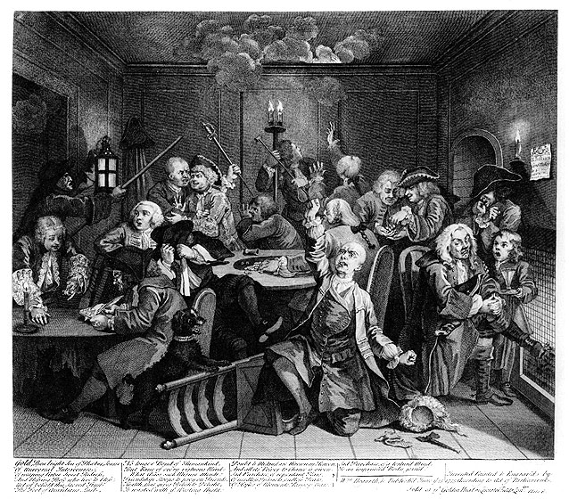
- 10. In 1705, the ‘Groom Porter’ was given full power by Queen Anne “to supervise, regulate, and authorize (by and under the Rules, Conditions and Restrictions by the Law prescribed) all manner of Gaming within this Kingdom”, The London Gazette (5-6 Dec. 1705).
Gambling as Social Performance
Gambling had an important social function. The gambling fever led to a situation in which the ability to play the most fashionable games was seen as a prerequisite for entering polite society. The rules of etiquette and the mastery of sociable pastimes were integral to the conduct manuals of the time, as part of gentlemanly culture. The one who could not play was considered as not well educated and unfit for the polite circles he aspired to integrate: 'Gameing is become so much the Fashion among the Beau Monde, that He, who in Company should appear ignorant of the Games in vogue, would be reckon’d low bred, and hardly fit for Conversation.'11
- 11. Richard Seymour, The Court Gamester: or, Full and Easy Instructions for Playing the Games now in Vogue (London: E. Curll, 1719), p. iii.
Lord Chesterfield wrote to his son: 'I thought Play another necessary ingredient in the composition of a Man of Pleasure.'12 And this, notwithstanding the deleterious effects of gambling, which were often noted: 'Gaming may have many ill consequences, I will not deny it, but since it is so establish’d a Custom, that it is a sort of Rusticity and Ill-breeding not to Game.'13 Despite its subversive character, gambling promoted sociability and was considered by many as essential to the education of the gentleman. It not only provided him with entertainment, but also with an opportunity to strengthen his social status—or to jeopardise it.
Appearances being one of the keys to social prestige, the performance associated with gambling was part of the dynamics of 'conspicuous consumption.'14 Mastering the rules of fashionable games, laying a wager for mere pleasure, losing with elegance, were skills that vouched for the public respectability of a gentleman, provided that he had good manners and conversation. Therefore, gambling was often ritualized and required the control of one’s emotions. For instance, faro players at Brooks’s relentlessly reproduced the same gestures:
- 14. Thorstein Veblen, Theory of the Leisure Class [1899] (Oxford: Oxford University Press, 2007), p. 53.
They began by pulling off their embroidered clothes, and put on frieze great-coats, or turned their coats inside outwards for luck. They put on pieces of leather such as worn by footmen when they clean knives, to save their lace ruffles; and to guard their eyes from the light and to prevent tumbling their hair they wore high-crowned hats with broad brims and adorned with flowers and ribbons, masks to conceal their emotions.15
- 15. Horace Walpole, The Last Journals of Horace Walpole During the Reign of George III, from 1771-1783, 2 vols. (London New York: John Lane, 1910), vol. 1, p. 7.
Distinction and good manners were prescribed by norms of politeness, and by a system of values dear to the aristocracy, the code of honour.16 To pay one’s gambling debts, for example, was a proof of honour and integrity. 'Debts of honour' (gambling debts due to other gentlemen) were the first ones that one should pay. By following the rules and rituals attached to gambling or betting and by paying his debts, the gentleman aimed to uphold his social status: 'aristocrats did not gamble to win, but rather to project a self-image of honour.'17 This provided the gentleman with an air of distinction and shaped his identity within this social group. Gambling was an activity through which a gentleman may affirm his rank and acquire social prestige.
- 16. On honour, see for instance Donna Andrew, Aristocratic Vices. The Attack on Duelling, Suicide, Adultery, and Gambling in Eighteenth-Century England (New Haven: Yale University Press, 2013), chapter 1.
- 17. Gerda Reith, The Age of Chance: Gambling in Western Culture (London: Routledge, 1999), p. 65.
Yet, some great gambling figures experienced unequal social success, essentially because of their excessive gambling habits. In spite of his high losses at play and debts, Charles James Fox, the soul and spirit of Brooks’s Club, was respected as a clubman: '[…] that amazing genius and prodigal scholar, wit, statesman, gambler, rake, affectionate husband, and the best loved man of his time.'18 On the contrary, Beau Brummel’s gambling addiction spelt his eventual social downfall. Brummell’s debts of honour were always paid immediately. The one exception was the final wager in White’s betting book, which was marked 'not paid, 20th January, 1816.'19 Consequently, Brummell, owing thousands of pounds, fled to France to escape debtor’s prison.
Gambling as a Vice
Gambling was often denounced as a vice, generating material and moral evil effects for the gambler and his relatives as well as for society as a whole. As early as 1685, Jean Frain du Tremblay, in a treatise entitled Conversations morales sur les jeux et les divertissements, considered gambling as a sinful pastime:20 Théophile complains to his friend Eugène that the gambling passion has reached such a height that it escapes all rules or measures (Frain du Tremblay 2). The two characters also lament the cruelty of gambling, which requires that the one wishes the ruin of the other, thus encouraging enmity: 'les joueurs sont ennemis d’eux-mêmes et de leurs propres familles.' (Frain du Tremblay 133, 103)
In 1750, in one of his Rambler articles, Samuel Johnson unveiled a list of complaints:
- 20. “[U]n divertissement [qui] vient du péché,” Jean Frain du Tremblay, Conversations morales sur les jeux et les divertissements (Paris: A. Pralard, 1685), p. 16.
I have received so many, or so earnest complaints, as of the predominance of play; of a fatal passion for cards and dice, which seems to have overturned, not only the ambition of excellence, but the desire of pleasure; to have extinguished the flames of the lover, as well as of the patriot; and threatens, in further progress, to destroy all distinctions, both of rank and sex, to crush all emulation, but that of fraud, to corrupt all those classes of our people, whose ancestors have, by their virtue, their industry, or their parsimony, given them the power of living in extravagance, idleness, and vice, and to leave them without knowledge, but of the modish games, and without wishes, but for lucky hands.21
The power of gambling was thus seen as destructive of society as well as of the individual, and of the individual’s duty to society. Gaming was also deemed a threat to religion. Hence for instance Frain du Tremblay’s advocacy of prayer as the only remedy to curb this gambling frenzy (Frain du Tremblay 38).
- 21. Samuel Johnson, The Rambler, n° 15 (8 May 1750).
While public gambling thrived, gambling in private houses was increasingly seen, from the middle of the eighteenth century, as a threat to public order and virtue. The gambling clubs of London were accused of all the evils of society and even of ruining social relations: 'there is now no society.'22 The author of a pamphlet, a member of Parliament, advocated the creation of an association which would either regulate private gambling clubs or suppress them: 'These nocturnal assemblies, […] it must be the business of the ASSOCIATION OF REFORM, to restrain under proper regulations, or totally to annihilate' (Hints for a Reform, 15).
- 22. Hints for a reform, particularly in the gambling clubs, By a MP (London, 1784), p. 14.
The literature of the time brings into focus the different attitudes to gambling. Gambling could be seen as the prerogative of the well-bred man, as in George Farquhar’s The Beaux Stratagem:
Sullen: Can you play at whisk?
Sir Charles: No, truly, Sir.
Sullen: Nor at All-Fours?
Sir Charles: Neither!
Sullen [aside]: Oons! Where was this Man bred?23
While in Shirley’s The Gamester the different characters indulge in gaming without any consequences, Susanna Centlivre’s Gamester (1705) suggests the possible reformation of gamblers. The necessity of reforming gamblers appears more clearly from the middle of the eighteenth century. Edward Moore’s tragedy The Gamester (1753) warns against the perils to which gaming can lead. The representation of gaming in literature contributed to the debates surrounding such practice, perhaps even influenced them. Gambling could also be a powerful means of losing an income, as Smollett’s hero finds out in Roderick Random (1748), while on the other hand the gambler who makes an income through her or his activities runs through the novel, from Defoe’s Moll Flanders (1722) to Thackeray’s Barry Lyndon (1844), set in the eighteenth century, which portrays Barry and the Chevalier as ruthless gamesters. By contrast with his son, Sir Charles Grandison, in Richardson’s eponymous novel, Sir Thomas embodies a type of masculinity based on gambling, betting on horses, and debts of honour. Smollett’s Ferdinand (The Adventures of Ferdinand, Count Fathom, 1753) is excellent at calculating the odds at dice but is fleeced by a sharper who has loaded the dice. The sharper was a stock character of fiction who appeared in plays such as Centlivre’s Gamester or in John Vanbrugh and Colley Cibber’s The Provok’d Husband (1728), and was perhaps more frequent in fiction than around card or dice tables. While Steele led a crusade against sharpers in the Tatler, Queen Anne’s gaming act of 1710, by limiting the maximum allowable loss, made it an offense for an individual to earn a living by gambling.
- 23. George Farquhar, The Beaux Stratagem [1707] (Edinburgh: G. Hamilton & J. Balfour, 1755), p. 89.
While Robert Burton had considered gaming and other immoderate pleasures as direct consequences of the English melancholy, the connection between gambling, duelling and suicide was made explicit from the middle of the eighteenth century:24 'gaming is one of the principal causes of duels and […] many a young fellow has owed his death to cards and dice. I have even imagined, that I heard bullets rattle in the dice-box, and that I saw challenges written upon every card on the table.'25 Great gamblers were often reputed for having a propensity to fight, as attested for example by famous duels opposing Lord Townshend to the Earl of Bellamont (1773), C. J. Fox to a Mr Adams (1779) or the Earl of Shelburne to Colonel Fullardon (1780).
Four activities were singled out by eighteenth-century contemporaries as belonging to a system of vice and corruption: duelling, suicide, adultery, and gambling. They originated in the 'besetting failing of the upper class—pride.' (Andrew 4) Duelling and suicide came to be considered as “the two children of gaming” (Gentleman’s Magazine, 1787): gaming was allegedly born from the union of the goddess of Fortune with the god of War. The child was only interested in cards and dice and exerted a fascination on male and female admirers alike. Strongly attracted by sword men, gaming was then united to one of them and from this alliance twins were born: duelling and suicide. Hence their mother cherished them and all three became inseparable. Following Richard Hey’s Three Dissertations on the Pernicious Effects of Gaming (1783), on Duelling (1784) and on Suicide (1785), Charles Moore published in 1790 an essay entitled A Full Inquiry into the Subject of Suicide. To which Are Added (As being closely connected with the subject) Two treatises on Duelling and Gaming.
Finally the economy of gambling brought about debts and ruins to a number of individuals. The narratives are all similar and tell of young and inexperienced men being enticed to play a variety of games (cards and dice, mainly, sometimes chess), drinking too much and finding themselves in debt. For instance, Thomas Fellows, sugar baker of London, claimed he was drawn against his will into drinking and gaming by an old school friend. He lost his money at hazard, passage,26 dice and hustlecap.27 The plaintiffs usually ascribe their losses to cheats and sharpers, such as the individual 'thoroughly skilled in all the acts and methods of play and having no other way of living but by what he gained off play did make it his business to inveigle and draw in young gentlemen to play at cards, dice and other games with him.'28
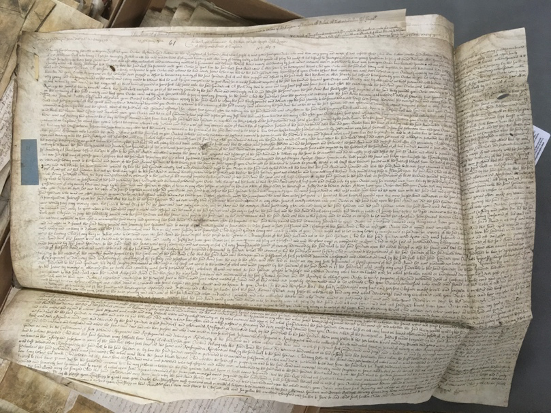
Literature also echoes the concern for gambling debts: Wickham, in Pride and Prejudice is heavily in debt; Willoughby, in Mansfield Park cannot marry Marianne because of debts; Tom Bertram, in Mansfield Park, cannot provide his brother Edmund with a living because of his gambling debts. Gambling enables the novel to explore issues of risk, chance, and probability.29
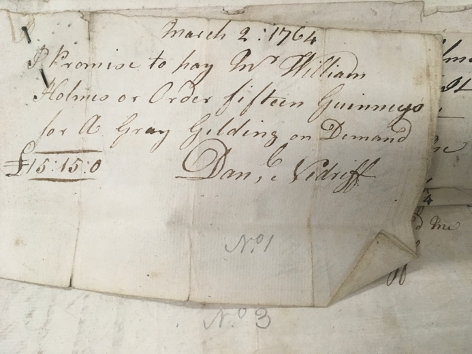
At the end of our period, the most vocal critics of gambling found that it had corrupted English society, accounting for the loss of the American colonies, and more generally for the degeneracy of the ruling classes. So that 'gambling was a form of anti-social sociability, a miniature war of all-against-all.' (Andrew 193)
- 29. For a comprehensive examination of gambling in eighteenth-century novels, see Jessica Richard, The Romance of Gambling in Eighteenth-Century Britain (Basingstoke: Palgrave Macmillan, 2011).
Partager
Références complémentaires
Cottegnies, Line and Louise Fang (eds.), ‘Playing, Gambling and Cheating in Early Modern England and France’, Études Épistémè, (n° 39, 2021). OpenEdition Journals, https://doi.org/10.4000/episteme.9414
Harris, Bob, Gambling in Britain in the Long Eighteenth Century (Cambridge: Cambridge University Press, 2022).
Lucas, Theophilus, Authentick Memoirs Relating to the Lives and Adventures of the Most Eminent Gamesters and Sharpers, from the Restoration of King Charles (London, 1714).
Miers, David, Regulating Commercial Gambling: Past, Present and Future (Oxford: Oxford University Press, 2004).
Mullin, Janet E., A Sixpence at Whist: Gaming and the English Middle Classes, 1680–1830 (Woodbridge: Boydell Press, 2015).
Munting, Roger, An Economic and Social History of Gambling in Britain and the USA (Manchester: Manchester University Press, 1996).
